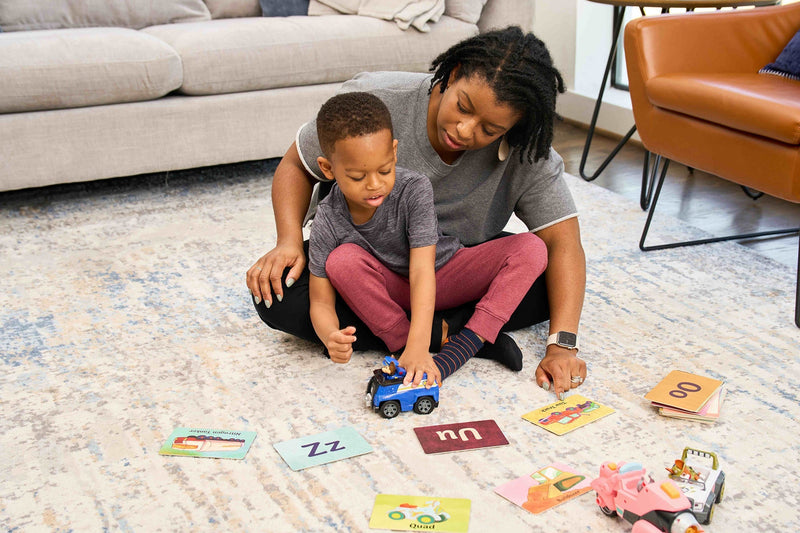FREEBIE: Downloadable Morning Messages!
If you've ever visited an early childhood classroom, chances are you've seen kids engaged in some sort of morning message. You might see them singing songs about the days of the week, creating patterns on a calendar, and of course: reading a morning message with the teacher.
And there's a reason why almost every teacher starts their day with a morning message: because they work! And in this post, I'll share with you why they work and how you can start a morning message routine with your little one at home!
What is a morning message?
Let's start with the basics: a morning message is a message that we write for our kids at the beginning of the day. It can be short or it can be long. It can be serious or it can be silly. It can be packed with academic skills or simply talk about the day coming up. You can adjust the content of your message to meet your little one where they're at. But no matter what, just make sure to bring your energy and excitement to help get them ready for the day!
Why should you do a morning message with your little one?
Morning messages are a great opportunity to build your child's excitement for the day. You can use them to talk about what activities you have planned or different things going on in their life. You can use them to ask your child questions that spark conversation or teach them lessons that they can carry with them over the course of the day. Think of a morning message like a dedicated, 1:1 time every day to connect with your child in a meaningful way. And do with that time what you will!
You can also use morning messages to practice different skills like identifying letter sounds, counting, patterns, tricky words, shapes, colors, and countless other things. Once you figure out which skills your little one needs to work on, you can fold those skills into your morning message for some quick, additional practice (all while getting that 1:1 quality time with them)!
How to do morning message at home!
Incorporating a morning message into your routine is simple. Just follow these 5 steps to get started:
1. Pick a morning message template. You can make your own, or use one of the downloadable messages from our Morning Messages freebie. Here's an example:

.jpg)
I like to start morning messages with the date (we learn how to read this together) and a greeting: something like "hi", "hey", "hello", or "good morning". Then, I move to the middle of the message: this is the part where we talk about the day, ask questions, build in skills etc. (more on this below). And finally, I close the message with something like "love" or "sincerely" along with my name.
2. Write your message. You can write your messages however you'd like. Some folks do this on a piece of computer paper, some folks fill-in our free templates, and some folks copy the message onto a larger piece of paper (like chart paper) to read.
Personally, I chose to invest in a big pack of chart paper to do these with my son but when you're just starting out, simply filling in and reading the piece of paper together will do the trick! The content of what you write and discuss with your child is more important than what it looks like : )
3. Choose one or two skills to practice. If you're able to incorporate skills your child is working on while you (or they) read the morning message, you'll add even more value to your time together. For example:
- If your child is working on specific letter sounds, they can find and circle all of the times they see those sounds
- If they're working on counting, you can have them count the number of words in a sentence.
- If they're working on specific tricky words, you can include those words in the message and have them find and read those words to you
- If they're working on reading 2 and 3 sound words, you can simplify your language and have them read the shorter words to you while you read the longer words to them
4. Discuss a question. This part is optional, but ending your morning message with a question is a great way to start a conversation with or learn from your little one. Not only will this help to develop their oral language skills (make sure to encourage them to use more words, try new vocabulary, and build on their ideas) but it will also get them excited about some sort of topic that is relevant to the day (like the current season, or activities that are coming up, or things your family celebrates).
Grab our free downloadable morning messages for an example of strong questions for a morning message routine.
5. Talk about the day. Reading together is great. Building in academic skills is valuable. Asking questions is helpful. But talking about the day ahead is critical. This is why we do a morning message in the first place. So make sure to foreshadow all of the big events of the day. Note anything that they'll look forward to, anything that's out of the typical routine, anything you want them to focus on doing well, and anything else that will help to set the right tone for the day ahead!
This is where you know your kid best. So lean into your creativity (or download the free messages) and get started!
FREEBIE: Downloadable Morning Messages!
It's important to note that these steps are just a guideline to help you get started. There's not necessarily a "right" or a "wrong" way to do a morning message, and it might take some time to figure out what works best for you and your child. So my best advice to you is to do whatever feels right and brings your little one joy!
But if you do need a little guidance on what to do, I have free downloadable morning messages to help you get started. The messages are already written for you- all you have to do is fill in the details (like your child's name and the date) and you'll be good to go. There are also blank messages at the bottom when you're ready to write your own.
Remember: Don't make this more complicated than it needs to be. The goal is to spend a little 1:1 time together at the beginning of each day. So no matter how you decide to do your morning messages, I know you'll use it as an opportunity to connect with your child and watch them grow.









